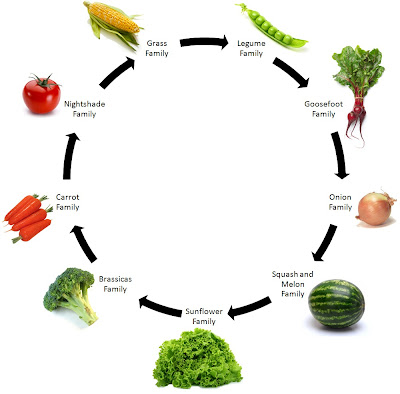And it's really hard when you're a home gardener with not alot of space. That doesn't mean you can ignore it, though. I had always heard that it's not a good idea to re-plant tomatoes in the same place that you did last year, but I never knew why. Well, Scientific evidence shows (and farmers know this thought experience) that trying to grow the same crop in the same place year after year can result in stunted growth and rampant plant diseases. In fact, a study by Penn State shows that the probability of tomatoes contracting early blight rose from 3% to 74% after they were planted in the same location for 3 years in a row.
So how do you figure out a workable crop rotation plan as a home gardener?
You start with the basics: understanding what the 9 main families are in the vegetable world. Then step 2 is just avoiding planting a plant in the same location as one of its family members occupied last year, and you should be golden. Here are the 9:
Nightshade Family
Nightshade includes tomatoes, peppers, eggplants, and potatoes. All of these will heavily deplete your soil of nutrients so you'll need to fertilize before planting another crop. Perils of replanting in the same space: Increased problems with blight and pests like tomato hornworm.
Legume Family
Peas and beans are legumes. Legumes are really beneficial plants in that their roots inject nitrogen into the soil. These would be a great choice to follow a Nightshade planting in your crop rotation schedule.
Squash and Melon Family
It's pretty easy to guess what goes here: summer and winter squash, cucumbers, pumpkins, and melons. These are also heavy feeders and will deplete your soil nutrients over time. The big pest here that will cause problems if you don't rotate is the squash vine borer and the squash bug, which will overwinter in the soil. I had these attack my pumpkin vines last year and, let me tell you, they are a PAIN!
Brassicas and Salad Greens Family
Leafy greens such as arugula, broccoli, cauliflower, rutabagas, kohlrabi, Brussels sprouts, cabbage, and kale (NOT lettuce!) are in this family. Because they put on such a large amount of green growth, they are highly dependent on lots of nitrogen during the growing season.
Sunflower Family
Sunflowers are in this family, of course, but it also includes Jerusalem artichokes, lettuce and endive. All of these tread very lightly on soil and are light feeds, so they are good choices to either precede or follow a member of the Brassicas family.
Carrot Family
Along with carrots, this family includes celery, parsley, and parsnips. They like lots of organic matter but not lots of nitrogen as it can cause you to get some really funky looking roots. So you don't want to plant these anywhere you planted a legume the following season.
Goosefoot Family
Members include beets, spinach and swiss chard. This family is great because it will grown even in soil with low fertility, so they are a great follow-up crop for members of the Nightshade family.
Grass Family
Corn is the number one member here, but this family also includes oats, wheat and rye. It's a great follow-up for the spot where you prevously grew beans or peas, as it needs really good, fertile soil.
Onion Family
And last but not least is the Onion family which includes onions, garlic, leeks and scallions. Great at repelling pests but they require high fertility.
With this information, you should be able to identify a crop rotation schedule that will fit into your home garden. The idea is to come up with something that is logical: either left to right, front to rear, circular or otherwise. Here are a couple of examples:
Garlic ---> lettuce
Broccoli ---> bush beans
Onions ---> leafy greens
Peas ---> carrots
Garlic ---> shell beans
This year the big one for me is following up my large tomato plantings from last year with squash, cucumbers and bush beans. We'll see how that works out.
It's that time of year where we're all planning our gardens and getting hands in the dirt. I hope you found this information useful as you put together your plan and start thinking about next year (it's not too early for that is it?)




























Have you ever watched this video "Back to Eden"? He says if you garden this way you don't have to do crop rotation. I am trying it out to see how it works. This is a link to the video on my blog check it out its pretty awesome!
ReplyDeletehttp://theredeemedgardener.blogspot.com/2012/02/back-to-eden-gardening-gods-way.html
I thought that was VERY useful!
ReplyDeleteClint: No, I haven't but it's on my watch list. For some reason, I thought you had to pay to watch it, but now I see you have the link on your blog where you can watch for FREE! Thanks so much for the tip...
ReplyDeleteIs this mainly for year after year planting? My first crop of zuchinni,broc, and potatoes are just about done and I was trying to decide what to plant in their place. suggestions?
ReplyDelete